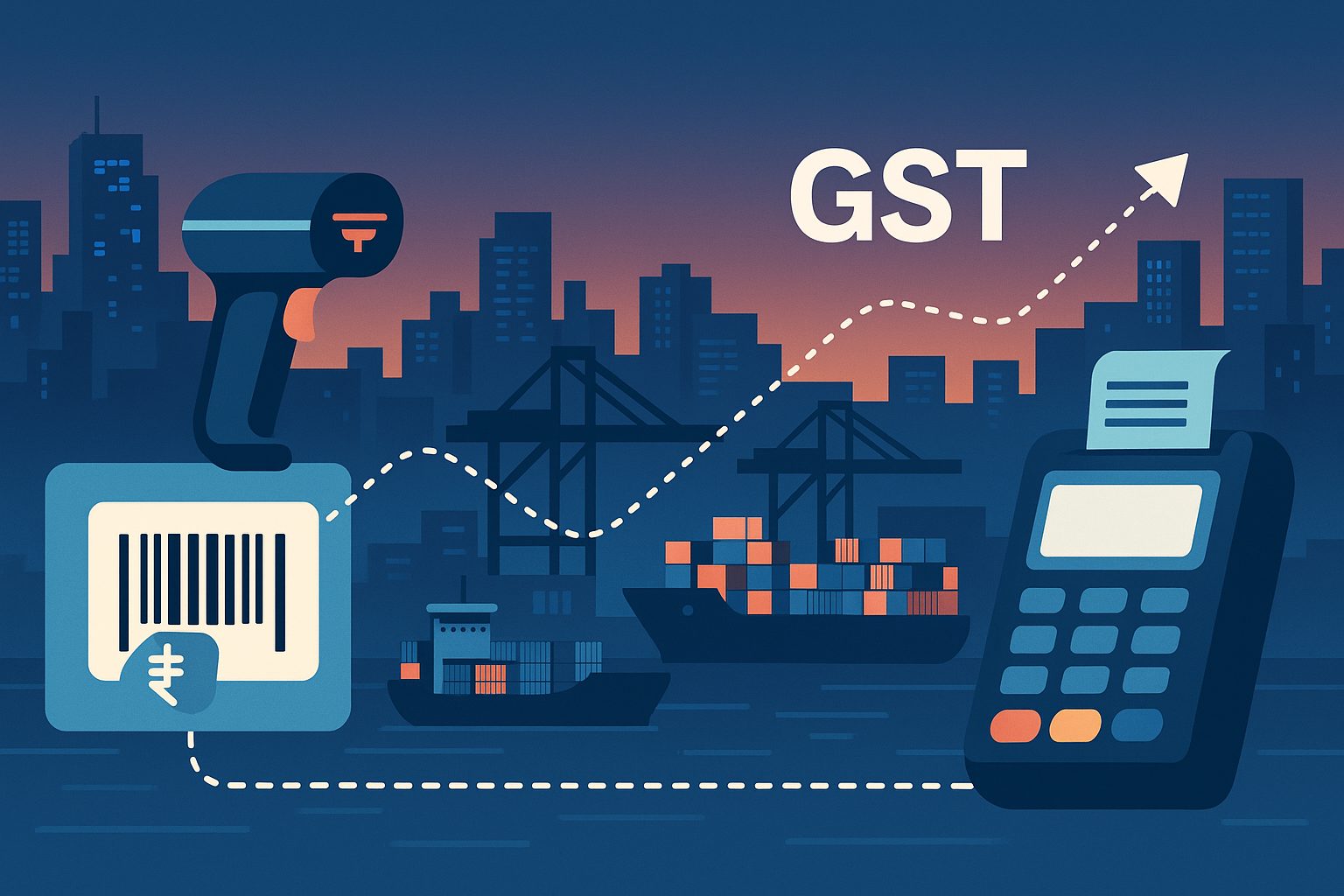Table of Contents
The May 2025 GST haul tells an unmistakable story of a marketplace in motion. India’s exchequer counted ₹ 2,01,050 crore in receipts for the month—up 16.4 percent on the same period last year. That back-to-back showing above the ₹ 2 lakh-crore line used to feel extraordinary; it is quietly settling into a habit.
Look beneath the headline and the spread is reassuringly broad. Central GST weighed in at ₹ 35,434 crore; states collected ₹ 43,902 crore. The interstate and import channel—IGST—added a chunky ₹ 1,08,836 crore, while sector-specific cesses provided ₹ 12,879 crore. Imports alone chipped in over ₹ 51,000 crore, signalling busy docks and active supply chains rather than a one-off spike.
Refunds—always the swing factor—came to ₹ 27,210 crore. Even after that deduction, net revenue stood at ₹ 1,73,841 crore, a hefty 20.4 percent leap year-on-year. In practical terms, that is more money for state treasuries, more elbow-room for capital projects, and a little extra breathing space for fiscal maths.
Two points matter most. First, the pattern—April was a record, May held firm. Second, the balance—no single slab is dragging the headline; they are all climbing together. If June follows suit, budget planners may start marking their spreadsheets in bolder ink.
How the Rupees Stack Up — A Closer Look
The raw numbers read well, but context turns them into insight. Break May’s GST inflow into its moving parts and four story-lines stand out.
Domestic sales hold their nerve
Shops, factories and service firms working entirely inside India generated ₹ 1,49,785 crore in tax this May—about ₹ 18,000 crore more than a year ago. The rise traces back to two features of the current regime:
- E-invoicing has widened the trail. Every large business now files near-real-time invoices; mid-sized firms have followed suit. Leakage that once slipped through paper bills is harder to hide.
- Consumption is broad, not patchy. Big-ticket items still sell, but everyday supplies—FMCG, light engineering goods, digital services—have filled order books as well.
Inside the domestic pot:
| Component | May 2024 | May 2025 | YoY change |
| CGST | ₹ 32,409 cr | ₹ 35,434 cr | +9 % |
| SGST | ₹ 40,265 cr | ₹ 43,902 cr | +9 % |
| IGST (inter-state) | ₹ 47,902 cr | ₹ 58,767 cr | +23 % |
| Cess | ₹ 11,207 cr | ₹ 11,683 cr | +4 % |
IGST on inter-state trade shows the steepest climb, reflecting busy trucking lanes and rail corridors.
Ports and runways do the heavy lifting
Imports poured ₹ 51,266 crore into the GST pool—up 25 percent year-on-year. Two reasons stand out:
- Capex cycle is alive. Industries are bringing in machinery, electronic parts and energy gear ahead of fresh project roll-outs.
- Commodity prices cooled off. With lower price tags, importers increased volume, pushing the taxable base upward even if each consignment cost less.
IGST on imports alone came in at ₹ 50,070 crore; import-linked cess added ₹ 1,196 crore.
Refund currents tell a health check
Refunds dropped to ₹ 27,210 crore, roughly 4 percent below last May. Fewer export-linked refunds and speedier reconciliation trimmed the outflow. A lower refund bill matters: it turns the gross headline into a sturdier net take.
| Refund type | May 2024 | May 2025 | Change |
| Domestic | ₹ 11,912 cr | ₹ 18,314 cr | +54 % |
| Imports (ICEGATE) | ₹ 16,446 cr | ₹ 8,896 cr | –46 % |
| Total | ₹ 28,357 cr | ₹ 27,210 cr | –4 % |
Domestic refunds rose as input-credit claims ticked up, but a sharp fall in export refunds more than offset that increase.
What flows into the Treasury
After refunds, May’s net GST revenue rests at ₹ 1,73,841 crore—a solid 20.4 percent jump over last year. That net figure funds highway projects, health missions, and the next round of GST compensation to states.
Why the split matters
- Policy pulse-check. A strong IGST line hints at buoyant trade corridors; states read that as a cue to expand warehousing and logistics.
- Cash-flow timing. Lower refunds mean quicker cash in hand for both Centre and states—vital for quarterly spending plans.
- Compliance signals. Balanced growth across CGST and SGST shows that audits, invoice-matching, and e-way-bill analytics are digging in evenly nationwide.
With two robust months already on the books, June’s figures will reveal whether the economy can keep this tempo—or whether May was the high-water mark before monsoon season normalises activity.
State-by-State Pulse
GST is collected nationwide, but the energy behind the numbers is regional. A handful of states power the overall rise; others move more slowly, and a few slip back. Mapping that spread offers clues to local demand, industrial output, and logistics flow.
Who tops the chart?
| Rank | State / UT | May 2025 Collection (₹ crore) | YoY Change | Quick take |
| 1 | Maharashtra | 31,530 | +17 % | Auto, finance and port traffic keep registers ringing |
| 2 | Karnataka | 14,299 | +20 % | Electronics exports and digital-service hubs lift bills |
| 3 | Tamil Nadu | 12,230 | +25 % | Textiles, engineering goods, and a strong retail backbone |
| 4 | Gujarat | 11,737 | +4 % | Petro-chem volumes stay steady; growth slower after a high base |
| 5 | Delhi | 10,366 | +38 % | Wholesale trade and e-commerce fulfilment spike post-year-end sales |
Maharashtra alone accounts for roughly one-in-six rupees of the nationwide GST pot—no surprise given its mix of manufacturing and services. Karnataka and Tamil Nadu continue to ride a tech-plus-industrial tailwind. Delhi’s jump hints at stronger distribution play and retail turnover after April’s big tax close.
Movers in the middle
States with mid-range economies still show healthy traction. Uttar Pradesh held flat, but West Bengal (+18 %) and Telangana (+6 %) nudged higher. Odisha (+2 %) and Chhattisgarh (+1 %) ticked upward, likely cushioned by mineral dispatches even as commodity prices cooled.
Outliers and laggards
- Chandigarh (+53 %) and Arunachal (+53 %) booked giant percentage gains, though on smaller bases.
- Manipur doubled its collections, a sign that border trade and new compliance drives are kicking in.
- Uttarakhand (-13 %), Andhra Pradesh (-2 %), and Mizoram (-26 %) slipped. Factory downtime, seasonality, or delayed invoice cycles can cause such dips; June data will confirm whether it is trend or blip.
Why the regional lens matters
- Supply-chain signals. Surge states often sit on key freight corridors; trucking firms watch these tallies to plan fleet deployment.
- Policy targeting. A dip in one region may push tax authorities to refine enforcement or offer filing support.
- Investment scouting. Consistent high-growth states draw warehouse developers and fintech lenders looking for volume-rich clusters.
GST data, month after month, becomes a live barometer of micro-economies. May’s numbers show the southern and western belts still in front—and a few smaller geographies catching up quickly.
What Powered the May Jump?
Numbers rise only when something real moves beneath them. May’s extra GST rupees can be traced to four very practical drivers.
E-invoicing moved down the food chain
Last year only the big boys—firms above ₹10 crore turnover—had to raise e-invoices. From April, the bar dropped to ₹5 crore. Thousands of medium-sized wholesalers switched to live invoice feeds in the GST network. Leak-proof billing pushed more tax into May’s ledger.
Import pipelines stayed busy
Orders for specialised machinery, solar gear, and semiconductor parts landed in bulk. Customs data show IGST on imports leapt 25 percent year-on-year. When ports work overtime, so does the tax meter.
Retail holds its ground between festivals
May sits between two Indian spending peaks—year-end clearance in March and the festive rush that begins in August. Even so, point-of-sale data from major chains show footfall matching pre-COVID levels. Everyday consumption kept CGST and SGST lines ticking—small lifts, but spread across millions of bills.
Faster refund cycles free up cash, trigger repeat filings
Exporters waited weeks for credits two years ago. Automated ICEGATE processing now clears compliant claims in days. Faster refunds mean exporters can spin the wheel again sooner, bringing the next round of liability into the current month instead of the next. Counter-intuitively, a smooth refund pipe lifts net tax over time because businesses file and ship more often.
In short: technology, trade volume, steady consumer demand, and tighter refund plumbing all worked in concert. None of these shifts looks temporary, which is why tax planners are betting the ₹2 lakh-crore floor may hold through the monsoon quarter.
Why the Numbers Matter — and What Comes Next
A big collection figure means little unless it changes behaviour on the ground. Here are four ways the May 2025 GST windfall is already shaping decisions.
Budget makers get extra swing room
Every additional rupee flowing into New Delhi’s consolidated fund trims the deficit at the margin. If the ₹ 2 lakh-crore line holds for a few more months, the Centre can front-load highway contracts or rural capex without waiting for the autumn mini-budget. States benefit, too: higher SGST and IGST settlements land in their treasuries within 48 hours, loosening cash-flow bottlenecks for projects that typically stall in the first quarter.
Compliance tools prove their worth
The drop in refund outflows, coupled with a rise in gross mop-up, signals cleaner invoices and tighter checks. Tax authorities will double-down on AI-based reconciliation because the pay-off is visible: more revenue with fewer raids. For businesses, that means a lighter touch—provided their books stay clean.
Credit appetite may firm up
Banks watch GST data as a proxy for turnover. A stable, elevated tax trail gives lenders more confidence to release working-capital lines, especially to MSMEs. Add in quicker refunds and the cash cycle shortens, lowering the perceived risk for term loans tied to machinery or warehouse expansion.
Monsoon quarter could set the tone for FY 26
June through August normally sees a dip as truck movement slows in heavy rain. If collections stay near the current watermark despite bad weather, analysts will start pencilling in a full-year GST haul north of ₹ 2.2 trillion per month on average. That would revise growth forecasts upward and let policymakers lean a little less on borrowing.
Action Points for Companies on the Ground
The tax office has its own to-do list, but private players—manufacturers, traders, service firms—can also pull a few levers while the GST tide is running high.
Lock in working-capital headroom
- Check your refund clock. If claims have taken longer than ten days, sit with the accounting team and find the choke-point—often a mismatched invoice number or an unverified bank account.
- Use the data trail. Steady GST output gives lenders hard evidence of turnover; nudge relationship managers for better credit terms before the monsoon lull.
Tighten supplier compliance
- Scrub GSTR-2B each fortnight. A missing vendor filing can block your input credit and stretch cash by 18 percent overnight.
- Share dashboards downstream. When suppliers see their lag flagged in real time, most speed up return filing to avoid red-listing.
Map interstate lanes for cost leaks
- IGST is up 23 percent. Double-check whether every e-way bill matches the final invoice lane; stray routing often kicks consignments into a higher slab or penalty bracket.
- Consolidate low-value loads. Freight corridors are busy enough to justify part-truck consolidation, trimming duplicate tolls and check-post delays.
Prepare for rate-review chatter
- Strong revenue invites policy tweaks. If collections keep beating targets, rate-rationalisation proposals will surface again. Keep margin buffers on items that sit in the 12 percent or 18 percent slabs—those are usual candidates for adjustment.
Use data to forecast demand, not just tax
- GST mirrors real consumption. Spotting a surge in your product category’s tax outflow a month ahead can guide inventory builds or marketing spends better than lagging sales reports.
Conclusion
May’s figures confirm that India’s GST engine is idling high, not sputtering. Two straight months north of the ₹ 2 lakh-crore line would have sounded fanciful a couple of years ago; now it reads like the new baseline. The mix is healthy—steady domestic consumption, brisk interstate trade, and import channels humming along. Refund outflows are under tighter control, leaving more cash in the public purse just when budgets need room to breathe.
For businesses, the message is plain: a transparent tax trail is no longer a burden but a currency. It opens doors to smoother credit, sharper demand forecasts, and leaner supply chains. For policymakers, the momentum offers a rare luxury—choices. Spend more on growth, pare back borrowing, or bank a buffer for lean months ahead.
Monsoon rains will soon test freight lanes and factory schedules. If collections stay buoyant through July, the ₹ 2 lakh-crore watermark may turn from milestone to milestone marker—a line the economy crosses without ceremony each month.
FAQs
What was India’s total GST collection in May 2025?
How much GST revenue did the government retain after refunds?
Which GST component contributed the most in May 2025?
What was the IGST collected on imports in May 2025?
Which state reported the highest GST collection in May 2025?
How much GST did Karnataka and Tamil Nadu contribute?
What was the refund amount processed in May 2025?
How did inter-state trade impact GST revenue?
Which sectors likely drove the import-related GST growth?
Why is sustained ₹2 lakh crore+ GST collection significant?
A product manager with a writer's heart, Anirban leverages his 6 years of experience to empower MSMEs in the business and technology sectors. His time at Tata nexarc honed his skills in crafting informative content tailored to MSME needs. Whether wielding words for business or developing innovative products for both Tata Nexarc and MSMEs, his passion for clear communication and a deep understanding of their challenges shine through.















Can you provide Total turnover on which GST was charged in May 2025. Total GST collected and Total ITC claimed